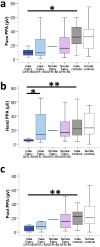Impaired small fiber conduction in patients with Fabry disease: a neurophysiological case-control study
- PMID: 23705943
- PMCID: PMC3672069
- DOI: 10.1186/1471-2377-13-47
Impaired small fiber conduction in patients with Fabry disease: a neurophysiological case-control study
Abstract
Background: Fabry disease is an inborn lysosomal storage disorder which is associated with small fiber neuropathy. We set out to investigate small fiber conduction in Fabry patients using pain-related evoked potentials (PREP).
Methods: In this case-control study we prospectively studied 76 consecutive Fabry patients for electrical small fiber conduction in correlation with small fiber function and morphology. Data were compared with healthy controls using non-parametric statistical tests. All patients underwent neurological examination and were investigated with pain and depression questionnaires. Small fiber function (quantitative sensory testing, QST), morphology (skin punch biopsy), and electrical conduction (PREP) were assessed and correlated. Patients were stratified for gender and disease severity as reflected by renal function.
Results: All Fabry patients (31 men, 45 women) had small fiber neuropathy. Men with Fabry disease showed impaired cold (p < 0.01) and warm perception (p < 0.05), while women did not differ from controls. Intraepidermal nerve fiber density (IENFD) was reduced at the lower leg (p < 0.001) and the back (p < 0.05) mainly of men with impaired renal function. When investigating A-delta fiber conduction with PREP, men but not women with Fabry disease had lower amplitudes upon stimulation at face (p < 0.01), hands (p < 0.05), and feet (p < 0.01) compared to controls. PREP amplitudes further decreased with advance in disease severity. PREP amplitudes and warm (p < 0.05) and cold detection thresholds (p < 0.01) at the feet correlated positively in male patients.
Conclusion: Small fiber conduction is impaired in men with Fabry disease and worsens with advanced disease severity. PREP are well-suited to measure A-delta fiber conduction.
Figures




Similar articles
-
Dyshidrosis is associated with reduced amplitudes in electrically evoked pain-related potentials in women with Fabry disease.Clin Neurophysiol. 2019 Apr;130(4):528-536. doi: 10.1016/j.clinph.2019.01.008. Epub 2019 Feb 4. Clin Neurophysiol. 2019. PMID: 30785009
-
Pain-related evoked potentials in patients with large, mixed, and small fiber neuropathy.Clin Neurophysiol. 2020 Mar;131(3):635-641. doi: 10.1016/j.clinph.2019.12.006. Epub 2019 Dec 26. Clin Neurophysiol. 2020. PMID: 31978848
-
Functional and structural nerve fiber findings in heterozygote patients with Fabry disease.Pain. 2009 Sep;145(1-2):237-45. doi: 10.1016/j.pain.2009.06.032. Epub 2009 Aug 7. Pain. 2009. PMID: 19665302 Clinical Trial.
-
Small fiber neuropathy in Fabry disease.Mol Genet Metab. 2012 Jun;106(2):135-41. doi: 10.1016/j.ymgme.2012.03.010. Epub 2012 Mar 24. Mol Genet Metab. 2012. PMID: 22497776 Review.
-
Early diagnosis of peripheral nervous system involvement in Fabry disease and treatment of neuropathic pain: the report of an expert panel.BMC Neurol. 2011 May 27;11:61. doi: 10.1186/1471-2377-11-61. BMC Neurol. 2011. PMID: 21619592 Free PMC article. Review.
Cited by
-
Studying serum neurofilament light chain levels as a potential new biomarker for small fiber neuropathy.Eur J Neurol. 2024 Apr;31(4):e16192. doi: 10.1111/ene.16192. Epub 2024 Jan 8. Eur J Neurol. 2024. PMID: 38189534 Free PMC article.
-
Clinical utility of contact heat evoked potentials (CHEPs) in a case of mentalis nerve lesion.Clin Neurophysiol Pract. 2018 Apr 7;3:74-77. doi: 10.1016/j.cnp.2018.03.004. eCollection 2018. Clin Neurophysiol Pract. 2018. PMID: 30215012 Free PMC article.
-
Phenotyping peripheral neuropathies with and without pruritus: a cross-sectional multicenter study.Pain. 2024 Dec 1;165(12):2840-2850. doi: 10.1097/j.pain.0000000000003300. Epub 2024 Jun 28. Pain. 2024. PMID: 38968397 Free PMC article.
-
Bridging the Gap Between Vessels and Nerves in Fabry Disease.Front Neurosci. 2020 Jun 16;14:448. doi: 10.3389/fnins.2020.00448. eCollection 2020. Front Neurosci. 2020. PMID: 32612493 Free PMC article.
-
Stratification of patients with unclassified pain in the FabryScan database.J Pain Res. 2019 Jul 23;12:2223-2230. doi: 10.2147/JPR.S206223. eCollection 2019. J Pain Res. 2019. PMID: 31413620 Free PMC article.
References
-
- Torvin Moller A, Winther Bach F, Feldt-Rasmussen U, Rasmussen A, Hasholt L, Lan H, Sommer C, Kolvraa S, Ballegaard M, Staehelin Jensen T. Functional and structural nerve fiber findings in heterozygote patients with Fabry disease. Pain. 2009;145:237–245. doi: 10.1016/j.pain.2009.06.032. - DOI - PubMed
Publication types
MeSH terms
LinkOut - more resources
Full Text Sources
Other Literature Sources
Medical
Miscellaneous

